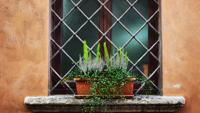Close
Greenspace: Sacred Herbs
As a Master Gardener, I often get asked which ten or twelve herbs are the most important to grow in a garden. I usually tell people that they should grow those things which their families will use and enjoy. This isn’t what most people want to hear. They want a list; grow this, and this, and this. For the past 35+ years I’ve worked with food storage, food preservation, and emergency preparedness, I’ve learned a great deal about herbs and what works for my family. The point is, that what “works” for my family may not be the same thing that works, or is useful, for yours.
Most gardeners are more interested in culinary herbs than in medicinal herbs. Many plants serve a dual purpose and for the past several years I’ve written articles about them one by one. Some gardeners have a higher purpose in growing herbs— that of sacredness. I’m speaking about those plants and herbs that people hold in high esteem to help them achieve the divine.
Herbs have been used in religious ceremonies and practices since the beginning of time. Their uses embrace incense, protection, cleansing, ritual, healing, purification, smudging, and as a gateway to vision. Each civilization and society has had their own favorites. It’s very interesting that many of the same herbs have place and keep “cropping up” (pun intended) across the continents and ages.
In Ancient Egypt chamomile, verbena (vervain), the blue lotus, cornflower, hyssop, garlic, roses, frankincense, and myrrh were often used in magic, and in religious observances. The Babylonians had their own special choices—the opium poppy, thyme, mustard, coriander, cinnamon, and garlic. The Babylonians also used saffron and white sage in certain religious ceremonies and cannabis was widely grown and used.
The recorded sacred herbs of early India (from 2000 BC) included soma. Soma was a drink made from the juice of stems of a plant. The ancient Persians used a soma potion, as well. The mention of whatever herb soma is made from is, in context, archaic and confusing. However, from my research everything points to soma being either Ephedra pachyclada or Ephedra sinica or something closely related to it. It’s an evergreen that has hallucinogenic properties in heavy doses. Other herbs adopted were cannabis (bhang, ganja and charas), and tulsi (holy basil).
Early Christians also considered tulsi sacred and gave it another name— St. Basil. They considered several other herbs holy, such as rosemary, rue, sage, frankincense, myrrh, vervain (verbena), angelica, and St. John’s Wort (the “Christian” name for mugwort). Some of those herbs are still in use in some Christian ceremonies.
The ancient Saxons of the tenth century had a “charm” poem—a gathering of nine herbs that were used to ward off evil and promote positive energy (I’d say Chi, but that isn’t Saxon). It was rendered by the early Christian communities and pagan communities at the same time, although neither acknowledged the other. The nine herbs were fennel, thyme, crabapple, nettle, mugwort, lamb’s cress, betony, plantain, and chamomile. Neem (seeds and oil) and vervain (verbena) and were also considered holy.
The ancient Celts had seven herbs that were valued as sacred. They were dandelion, comfrey, mugwort, burdock, mistletoe, nettle, and the Guelder rose. The Druids had nine, although there are many disputations among historians and writers. Some say there were seven sacred herbs (like the Celts) and others twelve. The nine that are usually listed are henbane, mistletoe, vervain (verbena), clover, wolfbane (aconite), primrose, mint, mugwort, and anemone (Pulsatilla).
Many Native American societies share common sacred herbs for their smudging rituals. Most resources (and tribes) tell us of four sacred herbs for the four directions; sweet grass for the north, cedar for the south, tobacco for the east, and sage for the west. Other than the smudging herbs, nine herbs stand out as being used over and over in tribal religious ceremonies. These are mugwort, plantain, kinnikinnick, nettle, fennel, watercress, chamomile, viper’s bugloss (Echium vulgare), sweet cicely, and sumac. The tribes I grew up around had a different list: corn pollen, mugwort, plantain, yerba santa (Eriodictyon), peyote, bear medicine (osha root), roses (petals and hips), juniper berries, mullein and chamomile.
Kinnikinnick refers to a mixture of herbs considered sacred to the user. The name actually means mixed by hand. Each tribe, family and group made their own. Most blends contained barberry, sumac, red osier dogwood, willow bark, arrowroot, laurel, and/or mullein. The blend “recipe” is kept secret. It was smudged, smoked, or given as gifts and/or offerings.
The Zulus in southern Africa have vastly and understandably different sacred herbs. Their herbs of reverence revolve around protection and visions or dreams. Impeho is considered a sacred plant. Impeho is the Zulu name for the everlasting plant (Helichrysum) and is thought to give immortality. Wild dagga (Tshwala Bezinyoni) and Silene capensis roots were and are used to make ubalawu or dream potions. Calea zacatechichi is used for the same effect.
I included the Zulu plants because they are extremely potent, but the plants are “insignificant” to look at. Such is the nature of many powerful herbs. Perhaps this is why they are considered sacred. Many of the “weeds” we have in our yards, fields, gardens are just as powerful.
If I “had to” make a personal list of herbs that I hold dear, it would be a long list indeed. I cannot stop the list at ten, or even twenty. Certainly mistletoe, dandelion, comfrey, sage, chamomile, plantain, creeping Charlie, mullein, juniper berries, vervain, mugwort and garlic would be on my sacred list. What’s on yours?
Master Gardener Sydney J. Tanner nurtures her 10 children as well as plants, in Colfax.
Sprout new ideas
With our home & garden newsletter!







Comments
Post a Comment